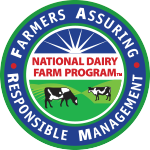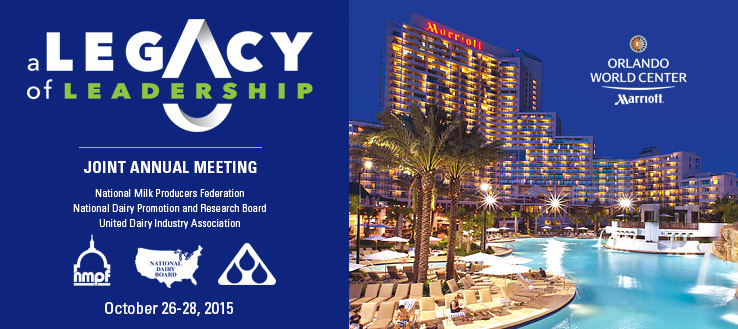 ARLINGTON, VA – Half of all workers on U.S. dairy farms are immigrants, and the damage from losing those workers would extend far beyond the farms, nearly doubling retail milk prices and costing the total U.S. economy more than $32 billion, according to a new report commissioned by the National Milk Producers Federation.
ARLINGTON, VA – Half of all workers on U.S. dairy farms are immigrants, and the damage from losing those workers would extend far beyond the farms, nearly doubling retail milk prices and costing the total U.S. economy more than $32 billion, according to a new report commissioned by the National Milk Producers Federation.
The report, which includes the results of a nationwide survey of farms, found that one-third of all U.S. dairy farms employ foreign-born workers, and that those farms produce nearly 80 percent of the nation’s milk.
It concluded that a complete loss of immigrant labor could cause the loss of one-in-six dairy farms and cut U.S. economic output by $32.1 billion, resulting in 208,000 fewer jobs nationwide. Some 77,000 of the lost jobs would be on dairy farms.
Retail milk prices, the report said, would increase 90 percent if all immigrant labor was lost. That would drive the supermarket price of a gallon of milk, which averaged $3.37 in June, to approximately $6.40.
The survey, an update of one done in 2009, was conducted last fall, before immigration became a hot-button issue in the presidential campaign. A comparison of the two surveys shows the number of immigrants working on dairy farms increased by 35 percent, or nearly 20,000, in six years. The portion of the milk supply coming from farms with immigrant labor increased by 27 percent.
The survey results do not distinguish between documented and undocumented foreign-born workers, but 71 percent of survey respondents said they had either low or medium level of confidence in the employment documents of their immigrant workers. As a result, the report said, a majority of dairy farmers are very concerned about actions such as immigration raids or employee audits. Despite this, 80 percent of dairy farms surveyed continue to hire immigrants.
“This report reinforces the urgent need for Congress to address this issue,” said NMPF President and Chief Executive Officer Jim Mulhern. “Farms that rely on hired foreign workers need their current labor force as well as an effective program to ensure an adequate future workforce. And the way to do that is to enact comprehensive immigration reform.”
“The notion that immigrants are taking these jobs away from American workers is simply not true,” added Randy Mooney, a dairy farmer from Rogersville, Missouri, and the chair of NMPF’s board. “Dairy farmers have tried desperately to get American workers to do these jobs with little success — and that’s despite an average wage that is well above the U.S. minimum wage.”
The report was produced for NMPF by Texas AgriLife Research at Texas A&M University. Researchers estimated that 150,418 employees worked on U.S. dairy farms in 2013, and that 51 percent of them, or 76,968, were immigrants. It found the average hourly wage on dairy farms in 2013 was $11.54, 16 percent higher than in 2008. By comparison, the federal minimum wage is $7.25 per hour.
The report concluded that a total loss of immigrant labor would reduce the size of both the U.S. dairy herd and the nation’s milk production by nearly a quarter. More than 7,000 dairy farms would close, it added.
Through economic modeling, researchers estimated that more than a third of the total economic damage from losing all immigrant labor on dairy farms would be from reduced farm milk sales. The rest would come from losses in employee compensation, reduced purchases by farm employees and lost sales to businesses that support dairy farms, such as feed and equipment dealers.
Likewise, researchers said, milk sales support many more jobs beyond the farm than on the farm. As a result, while a total loss of immigrant labor on dairy farms would mean 76,968 fewer people working on farms, it would also mean the loss of 131,240 jobs outside the farm.
Mulhern added that Washington’s failure to act on immigration reform is also preventing economic growth and job creation in other ways. “The lack of a reliable source of workers is causing farmers to second-guess decisions to expand,” he said. “That’s economic activity that’s lost to both rural and urban communities — all because Washington won’t act on immigration reform.”
###
The National Milk Producers Federation, based in Arlington, VA, develops and carries out policies that advance the well-being of dairy producers and the cooperatives they own. The members of NMPF’s cooperatives produce the majority of the U.S. milk supply, making NMPF the voice of more than 32,000 dairy producers on Capitol Hill and with government agencies. Visit www.nmpf.org for more information.
 To help dairy marketers and farmers feed consumers’ hunger for information about where their food comes from, the National Dairy FARM Program will be launching a new website this month. To help share the story of animal care on America’s dairy operations, this October, the FARM Program will be releasing a new suite of communications resources that includes a brand new, consumer-friendly and updated website; a catchy, modern, animated video explaining the program and a blog to talk about animal care.
To help dairy marketers and farmers feed consumers’ hunger for information about where their food comes from, the National Dairy FARM Program will be launching a new website this month. To help share the story of animal care on America’s dairy operations, this October, the FARM Program will be releasing a new suite of communications resources that includes a brand new, consumer-friendly and updated website; a catchy, modern, animated video explaining the program and a blog to talk about animal care.
 Carrie Hughes, a Texas native with experience in nonprofits, has joined the NMPF staff as executive assistant to President and CEO Jim Mulhern. She will provide administrative support by facilitating day-to-day workflow, coordinating business trips and completing special projects. She replaces Brenda Rowe, who worked under Mulhern for two years.
Carrie Hughes, a Texas native with experience in nonprofits, has joined the NMPF staff as executive assistant to President and CEO Jim Mulhern. She will provide administrative support by facilitating day-to-day workflow, coordinating business trips and completing special projects. She replaces Brenda Rowe, who worked under Mulhern for two years. OCTOBER 4, 2015 — The National Milk Producers Federation and the U.S. Dairy Export Council noted the conclusion today of Trans-Pacific Partnership (TPP) negotiations and thanked the U.S. negotiators for their work. NMPF and USDEC leadership and staff have attended the talks in Atlanta this week, which kicked off with a chief negotiators meeting on September 26 before shifting into a Ministerial on September 30. Both organizations have been providing input and guidance to negotiators throughout the duration of the regional trade pact.
OCTOBER 4, 2015 — The National Milk Producers Federation and the U.S. Dairy Export Council noted the conclusion today of Trans-Pacific Partnership (TPP) negotiations and thanked the U.S. negotiators for their work. NMPF and USDEC leadership and staff have attended the talks in Atlanta this week, which kicked off with a chief negotiators meeting on September 26 before shifting into a Ministerial on September 30. Both organizations have been providing input and guidance to negotiators throughout the duration of the regional trade pact.
 ARLINGTON, VA – Half of all workers on U.S. dairy farms are immigrants, and the damage from losing those workers would extend far beyond the farms, nearly doubling retail milk prices and costing the total U.S. economy more than $32 billion, according to a new report commissioned by the National Milk Producers Federation.
ARLINGTON, VA – Half of all workers on U.S. dairy farms are immigrants, and the damage from losing those workers would extend far beyond the farms, nearly doubling retail milk prices and costing the total U.S. economy more than $32 billion, according to a new report commissioned by the National Milk Producers Federation. With Congress back from its August recess, its members will face a slew of hot-button issues, including reviewing the Iran nuclear deal and appropriating money to stave off another government shutdown by Sept. 30. While numerous issues are near the top of Congress’ to-do list, NMPF will continue pushing on several bills that are important to milk producers. Here is what NMPF will be working to advance during the fall session:
With Congress back from its August recess, its members will face a slew of hot-button issues, including reviewing the Iran nuclear deal and appropriating money to stave off another government shutdown by Sept. 30. While numerous issues are near the top of Congress’ to-do list, NMPF will continue pushing on several bills that are important to milk producers. Here is what NMPF will be working to advance during the fall session: In less than two months, hundreds of dairy industry leaders will converge in Orlando, Florida, for the joint annual meeting between the National Dairy Board (NDB), the National Milk Producers Federation (NMPF), and the United Dairy Industry Association (UDIA). “A Legacy of Leadership” will take place from October 26-28 at the Orlando World Center Marriott.
In less than two months, hundreds of dairy industry leaders will converge in Orlando, Florida, for the joint annual meeting between the National Dairy Board (NDB), the National Milk Producers Federation (NMPF), and the United Dairy Industry Association (UDIA). “A Legacy of Leadership” will take place from October 26-28 at the Orlando World Center Marriott. On the last day of August, NMPF urged the Obama Administration to hold off on the national enforcement of the new Waters of the U.S. (WOTUS) regulation. This comes in response to a court decision suspending the regulation in some states, but not others.
On the last day of August, NMPF urged the Obama Administration to hold off on the national enforcement of the new Waters of the U.S. (WOTUS) regulation. This comes in response to a court decision suspending the regulation in some states, but not others.



